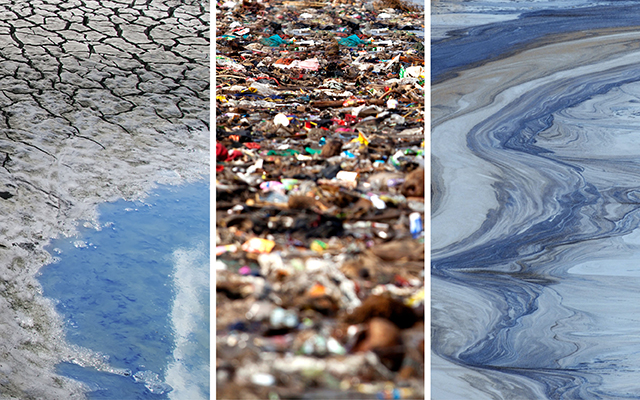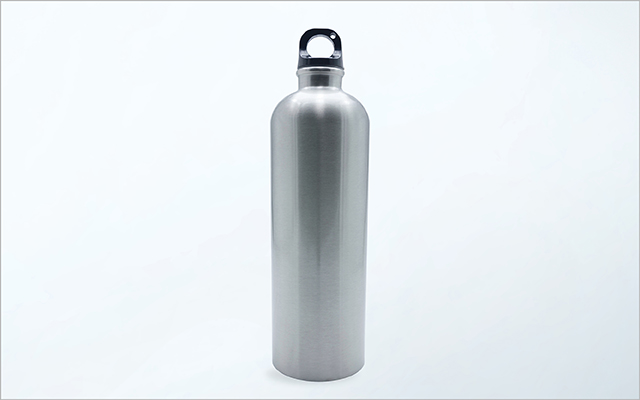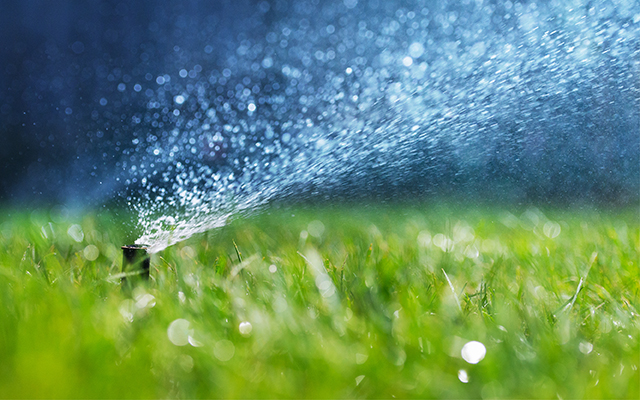Looking at a satellite photo of our mostly blue Earth, it’s hard to believe that we could ever worry about having enough water. But according to a March 2016 report from the United Nations Environment Programme (UNEP), almost half the world’s population will suffer “severe water stress” by 2030 unless water use is “decoupled from economic growth.” The UNEP defines water stress as when “the demand for water exceeds the available amount during a certain period or poor quality restricts its use.” The UN also reports that contaminated water is implicated in 80 percent of all sickness and disease in the developing world.
Many experts have suggested water will become “the new oil” — a scarce resource that triggers geopolitical conflicts. Severe drought in northern Syria, for example, forced thousands of rural people to abandon their lands and move to the nation’s cities beginning in 2006.
“You had a lot of angry, unemployed men helping to trigger a revolution,” Aaron Wolf, a water-management expert at Oregon State University, told Smithsonian magazine in 2013. That conflict has now become one of the most serious political and humanitarian crises of our time.
Because many of the most dramatic challenges involving water have affected the Southern Hemisphere, the crisis can seem remote — another distant Third World dilemma. Yet there are plenty of Americans for whom the water crisis is very real.
In April 2015, during a crippling drought in California (where a substantial percentage of the nation’s food is grown), Governor Jerry Brown ordered a 25 percent reduction in urban water use. Although the order was suspended the following June, and winter storms in early 2017 have eased the drought, the Pacific Institute, a Boulder, Colo.–based global water research group, reports that “drought impacts on overdrafted groundwater basins, forests, and aquatic species in California are long-term and will take multiple above-average precipitation years to be resolved.”
It’s not just California that’s been water stressed in recent years. In Atlanta, a city that typically receives a generous 45 inches of rain a year, the mushrooming population has substantially depleted municipal water supplies. Some government officials believe the city will go dry unless it taps into Lake Lanier, 50 miles to the northwest — and that means entering an ongoing “water war” with other parts of Georgia, Florida, and Alabama over Lanier and the rivers that feed it.
Meanwhile, underground aquifers in Florida have begun drying up, creating thousands of sinkholes — spots where the ground has given way, swallowing cars and houses.
These scenarios are frightening, but serious water scarcity is not a foregone conclusion. We can adapt to our dwindling resources by learning to conserve and adjust our water usage. Many talented engineers and scientists are already devising ever-more innovative ways to do this.
But first we have to understand the scope of the issue.
Read on to discover three of the primary threats to Earth’s fresh water and how to protect yourself, your loved ones, and the water we all need.
1. Limited Freshwater Supplies
Technically, we can never run out of water. All of Earth’s water circulates through the hydrological cycle of evaporation, condensation, and precipitation — it doesn’t disappear. But less than 3 percent of the planet’s water is fresh rather than salty, and only about a third of fresh water is available in rivers, lakes, and underground aquifers.
All those sources are under grave stress worldwide. Rapidly growing populations, increases in crop irrigation, and galloping urbanization deplete water reserves and shift water away from where it’s needed.
Burgeoning Sun Belt cities, for example, are battling subsidized corporate farmers in San Diego County and California’s Imperial Valley over access to the Colorado River, which has been so thoroughly dammed and diverted that it no longer reaches the sea. Instead, it trickles into a muddy basin in the deserts of Sonora, Mexico.
“There are about 35 million people who depend on the Colorado River for drinking water and household water use, and the river supplies industries and several million acres of irrigated land, as well,” notes Sandra Postel, director of the Global Water Policy Project in Los Lunas, N.M. “The Colorado River is overtapped. Lake Mead, which is behind Hoover Dam and is the biggest reservoir in the United States, is at about 37 percent capacity.”
By midcentury, the river could fail to meet the demands placed upon it up to 90 percent of the time, according to researchers at the Scripps Institute of Oceanography.
Our underground aquifers are comparably stressed. In her 2013 book, Blue Future, Canadian water activist Maude Barlow cites a projection by the U.S. Department of Agriculture that the massive Ogallala Aquifer, which provides most of the water for irrigated industrial-scale agriculture from New Mexico to western Kansas, will probably go dry in our lifetime.
This could cause food prices to soar, since this “breadbasket region” produces a substantial percentage of the nation’s corn and soybeans. As water grows increasingly scarce, its value will rise.
What You Can Do
Even if vanishing water doesn’t affect you now, it will in the future. So the first step is to educate yourself on the issues.
The next is to support the implementation of “good law,” says Maude Barlow, author of Blue Future. This may involve urging representatives to curtail subsidies to corporate farms that depend too heavily on irrigated land.
Ken Midkiff, author of Not a Drop to Drink: America’s Water Crisis (and What You Can Do), suggests that High Plains and western farmers curtail irrigation by using water-saving methods and planting less-thirsty crops. There are, however, substantial challenges facing support for these initiatives with agribusiness-friendly and regulation-averse interests currently dominating Washington, D.C.
You can also help by limiting your own water use, embracing thoughtful conservation methods, and teaching your children to do the same. This can be as simple as putting a plastic milk jug filled with stones in your toilet tank — which can save about a half-gallon per flush — and turning off the faucet while you brush your teeth, which can save up to 8 gallons a day. (For more conservation tips, see “Every Drop Counts” below.)
2. Pollution
Forty percent of our rivers and 46 percent of our lakes are unfit for fishing, swimming, or drinking. The main culprit: toxic runoff from large-scale farming operations and livestock feedlots.
The Mississippi River deposits 1.5 million metric tons of nitrogen pollution, chiefly from fertilizers, into the Gulf of Mexico every year. This feeds algae, creating massive dead zones in the Gulf, and has created algal blooms in the Great Lakes as well, making fresh water there unsafe for drinking.
Increasingly, prescription drugs are also showing up in our water. The majority of pharmaceutical pollution doesn’t come from manufacturing; it arrives in the water via human excretion or when people flush unused drugs down their toilets. According to a 2013 EPA study, medications for high blood pressure appeared most frequently and in the highest concentrations.
While there is no conclusive evidence that pharma-pollution harms human health, the nonprofit Environmental Working Group pointed out in 2008 that 13 percent of the 200 most popular drugs in the United States list serious side effects at levels less than 100 parts per billion, with some in the parts-per-trillion range. Scientists note that the long-term effects of individual drugs and drug combinations in our water are hard to predict, especially given that the U.S. population is aging and using — as well as flushing away — more drugs each year.
What You Can Do
Protect your local groundwater by using only natural fertilizers, pesticides, and herbicides on your lawn and garden. Choose less-toxic options, like vinegar and baking soda, for household cleaning.
Don’t flush pharmaceuticals down the drain. Read your utility’s annual water report to discover what chemicals are in your local supply and buy a filter that traps specific contaminants. (For more on this, see “Truth on Tap.”)
3. Privatization
Public management of water resources in the 19th and early 20th centuries was crucial in promoting public health and supporting industries, Barlow notes. It helped ensure that no single party could gain too much control over this vital community resource.
Times have changed. Major cuts in federal support for municipal water systems in the past 30 years have left many cities struggling for maintenance funds, forcing them to turn to private companies to manage their infrastructure. Some 50 million Americans now rely upon these for-profit businesses to deliver their water, according to the industry monitor Bluefield Research — and this number is likely to increase as deteriorating water infrastructures force more cities to turn to the private sector.
Private companies also bottle and sell drinking water; own and operate dams, desalination plants, water-purification systems, and pipelines; control vast amounts of water used in industry and agriculture; buy up groundwater rights; and trade in water-related stocks. Their rising influence on our water supply, Barlow writes, has produced “a legacy of corruption, sky-high water rates, cutoffs of water to millions, reduced water quality, nepotism, pollution, worker layoffs, and broken promises.”
The public consequences of privatizing water can be striking. In 1998, shortly after the multinational company Suez took control of the system in Sydney, Australia, residents discovered their water was contaminated by Giardia and Cryptosporidium.
The privatization of British water in 1989 led to an average 67 percent increase in water and sewage bills and a 177 percent rise in service cutoffs. A recent report from the European Public Service Union notes that water prices in Britain continue to rise: Between 2003 and 2013, bills increased by 64 percent.
Widespread protests erupted in Ireland in 2014 when public water, previously funded by tax revenue, was metered and users were billed. The plan was part of a bailout negotiated with the International Monetary Fund and the European Union.
Barlow makes a case for the parallels to oil by citing a 2011 quote from Citigroup’s chief economist, Willem Buiter: “I expect to see a globally integrated market for fresh water within 25 to 30 years. Once the spot markets for water are integrated, futures markets and other derivative water-based financial instruments . . . will follow. There will be different grades and types of fresh water, just the way we have light sweet and heavy sour crude oil today.”
What You Can Do
Let your elected representatives know that you care about securing an ample supply of safe, affordable water for your community. Be aware that private water companies often promise enticing revenue scenarios to city governments, and it can be tempting for public officials to capitulate. Stay informed and keep them accountable.
The Washington, D.C.–based consumer group Public Citizen (www.citizen.org) offers numerous resources for learning about and working against water privatization, as does Food & Water Watch (www.foodandwaterwatch.org). Maude Barlow’s Blue Planet Project site (www.blueplanetproject.net) is another comprehensive “water justice” resource.
Glimmers of Hope
There are some hopeful signs on the horizon. New conservation and irrigation techniques are helping reduce water waste. Even with existing technologies, says Sandra Postel, industrial facilities could save as much as 90 percent of their water by recycling it; farmers could cut their usage by as much as 25 percent.
Dry farming, an ancient technique in which farmers seal rainwater in the soil, is only one example. Still used in the Mediterranean and other regions, it was widely practiced in California from the 1800s into the early 20th century. The technique is enjoying a modest revival there today, with farmers who produce grapes, tomatoes, potatoes, cucumbers, melons, grains, and tree fruit.
Postel notes that more than a thousand dams have been removed from rivers and streams across the United States in the last quarter-century, restoring the free flow of portions of these waterways — and improving the lives of fish and other aquatic organisms. In October 2015, for example, the removal of the Memorial Park Dam on Pescadero Creek in Northern California opened 62 miles of water for migrating coho salmon.
Thanks to concerted action by activists — and the ongoing effects of deindustrialization — America’s rivers are actually cleaner than they were 30 or 40 years ago. Massachusetts’s Nashua River, which ran bright red with sewage and industrial waste in the 1960s, has been rendered relatively pristine by the Nashua River Watershed Association. The Credit River in suburban Scott County, Minn., was delisted from the state’s registry of polluted waters after citizens and local government pulled together, creating rain gardens to capture runoff from a nearby parking lot and planting vegetation to prevent bank erosion. Adopt-a-Stream, Save Our Streams, and other groups have been leaders in monitoring water quality and fighting pollution.
But great water-related challenges remain, and we can’t afford to bury our heads in the (increasingly dry) sand. The more we learn, the more we’ll be able to appreciate just how precious and vulnerable that simple, life-bestowing combination of hydrogen and oxygen has become — and the more we’ll be motivated to do what we can to protect it.
Every Drop Counts
The average American household uses 69 gallons of water daily, according to the American Water Works Association. The largest portion, about 18 gallons, goes to toilet flushing. Then comes clothes washing (about 15 gallons), showering (nearly 12 gallons), water faucets (11 gallons), and various leaks (9 gallons). Here are some ways to use less:
Toilet Train
A high-efficiency toilet uses 20 percent less water than a standard model, on average. But even the most efficient toilet won’t conserve water if it’s leaking. Mark the water level in the tank with a pencil when it has refilled after flushing. If the level drops after a few minutes, it’s leaking. A “running” toilet can waste 200 gallons per day. Find good leak-plugging information at www.thisoldhouse.com.
Then there’s flushing itself. A single flush can use 1.6 gallons to 7 gallons of water, depending on the toilet (low-flow toilets need less). So get used to keeping the lid down, and when there are no solids involved, conserve flushes.
Wash Smart
Do laundry less often to avoid half-loads. When it’s time for a new washer, go for a front-load; it uses one-third less water than a top-load. Washing machines certified by the EPA’s Energy Star program conserve both water and energy.
Shorten Showers
A 10-minute shower uses 50 gallons of water. A full bathtub may contain up to 70 gallons of water. Don’t be afraid to shower every other day instead of daily during cooler seasons: Your body will quickly adjust, and your skin’s microbiome (which can get depleted by too much soap) will thank you.
Tighten Up
Fix dripping faucets by replacing the washers. A one-drop-per-second drip can waste 2,500 gallons in a year.
Water Mindfully
The typical single-family suburban household uses at least 30 percent of its overall water use for lawns and gardens, according to the EPA. You can use less by watering at sundown or early morning; this helps water stay in the ground rather than evaporating in the sun. Experts estimate that more than 50 percent of landscaping water goes to waste from evaporation or runoff caused by overwatering.
(For even more ways to help, try these nine simple tips to reduce water usage in your kitchen.)
This article originally appeared as “Troubled Waters.”




This Post Has 0 Comments